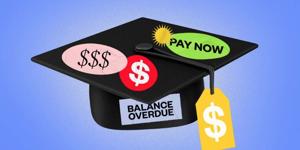
Joy Morales-Bartlett could finally see an end to her decades long student debt by the end of this year.
But her ability to pay it off now rests in the hands of the Supreme Court.
More than 40 million borrowers like Morales-Bartlett were eligible to cancel up to $20,000 in federal student loan debt under President Joe Biden’s one-time student loan forgiveness plan.
With a remaining balance of $19,000, the former University of California, Santa Barbara, student applied to the program as soon as it opened, with high hopes. Morales-Bartlett received an email from the U.S. Department of Education two weeks ago saying her application had been approved.
But instead, her debt and that of roughly 16 million applicants who were also approved may never be forgiven if the Supreme Court sides with lower courts in Republican-led states that blocked the program. A ruling is expected next year.
NBC News spoke to a dozen student loan forgiveness applicants nationwide, ages 24 to 60, who had hoped for relief from their crippling debt — which has left some struggling to afford medical expenses and basic necessities and others unable to buy a home or start a family.
“It’s disheartening,” said Morales-Bartlett, 46, a former teacher from California who has been paying off her $89,000 in student loan debt the last thirty years and is currently dealing with health-related issues. “We’ve done the right things this whole time, and we are being punished for it.”
The Biden administration has since closed the application process until the court decides the program’s fate sometime next year.
Meanwhile, the pandemic-era federal student loan repayment pause has been extended while the government awaits the court’s decision.
Struggling ‘until the day I die with this crappy debt’
The onerous cost of higher education is a persistent challenge as communities continue to encourage college completion, especially for groups such as Latinos who lag in the number of adults with college degrees, with recent gains set back by the pandemic.
Going to college is credited with greater opportunities for socioeconomic mobility.
For Daisy Pérez, 49, earning a college degree and becoming a registered nurse helped her family get out of poverty and “at least make ends meet,” her daughter Cristher Estrada-Pérez said.
Estrada-Pérez said her mother may never be able to pay off the $90,000 in student debt, which includes a Parent Plus loan for Estrada-Perez’s college tuition.
“She’s never going to be able to own a home and earn enough to retire,” Estrada-Pérez, 32, said.
The crisis has left parents and their adult children grappling with how to pay off student debt, which has been steadily rising in the U.S. for more than a decade, reaching $1.745 trillion this year. The average federal student loan debt nears $30,000.
Estrada-Pérez, who is also the executive director of the Student Loan Fund in Connecticut, which helps predominantly Black and Latino borrowers navigate their debt, is paying off $80,000 for her student loans.
As Federal Pell Grant recipients, Estrada-Pérez and her mother stand to get $20,000 in debt forgiveness if the Supreme Court rules to keep Biden’s program. But still, that barely covers the interest rates their loans have accumulated over the years, she said.
Estrada-Pérez, who majored in history at St. Joseph’s University in West Hartford, had aspired to become a lawyer, but “I couldn’t think about what my debt would look like if I even attempted to go to law school.”
Lisa Brown, 60, of North Carolina remembers paying for college at the University of Southern Maine with her parent’s help about four decades ago, when tuition was about $3,000 a year. Now, attending a four-year university can cost $25,000 to $55,000 a year on average.
After earning a bachelor’s in psychology, Brown returned to school in an attempt to improve her job prospects. She graduated from Walden University in 2002 with a master’s in forensic psychology.
This time around she ended up with $40,000 in student loan debt, which has almost doubled to about $70,000 over the past decade because of compounded interest. Brown also has a $17,000 Parent Plus loan — federal loans that parents of dependent undergraduate students can use — from when her 31-year-old son was studying sound engineering at an art institute in Boston.
At Brown’s age, medical bills are also starting to pile up, she said. Even with insurance, she is still paying a $2,600 balance from an operation she had two years ago.
“I’m going to struggle until the day I die with this crappy debt,” said Brown, who is looking for work. “If they’re going to make us continue to pay … then don’t make getting jobs harder for older people.” If approved, Brown could receive up to $10,000 in loan forgiveness under Biden’s program.
Brown’s son still has about $50,000 in student debt despite being one of the thousands of North Carolinians who received some student loan relief as part of a multistate settlement with Navient, one of the nation’s largest student loan servicers, over allegations of unfair and deceptive student loan servicing and predatory lending practices, according to North Carolina’s Attorney General Josh Stein‘s office. He also applied to the currently blocked student loan forgiveness program and is waiting to hear back.
The unresolved student debt crisis has many borrowers questioning whether the ends justify the means. Esther Jean-Marie is one of them.
The 30-year-old of Haitian descent graduated from the University of Hartford in 2015 and went on to complete a master’s in nonprofit management and philanthropy to increase her chances of making a livable wage and “set myself up for success,” she said.
After working multiple jobs to pay for college, Jean-Marie achieved her dream of doing nonprofit work, but still ended up with $88,000 in student debt.
First-generation college graduates such as Jean-Marie, Estrada-Pérez and Morales-Bartlett tend to have lower incomes and accumulate less wealth, on average, compared to those with a parent who has a bachelor’s or higher degree, complicating their ability to repay loans, according to a 2021 Pew Research Center analysis.
‘I needed time’
Alexis V. said she survived an act of sexual violence while studying business administration at the University of Southern California. She ended up taking a health leave and graduated in December 2013, a semester later than expected.
“It cost me thousands of dollars just because I needed time to process the trauma of sexual assault,” Alexis, who now has $55,000 in student debt, said.
According to a survey on sexual violence and student debt from the Sexual Violence Prevention Association, her experience is not unique. Experiencing sexual violence often leads to higher student loans and increased difficulty repaying the debt, founder and CEO Omny Miranda Martone said.
Alexis has been approved to receive $10,000 in loan forgiveness under Biden’s program. While it’s still significantly less than what she had hoped, as the first in her Filipino family to go to college, “I’d be better able to support my parents. My dad could hopefully be less stressed about retiring.”
The current pause on student debt repayment due to the pandemic has helped. It made it easier for Alexis to afford living on her own. For Martone (who uses they/them pronouns), not having the financial strain of repayment allowed them to pursue their goal of starting an organization to prevent sexual violence.
It also helped Jean-Marie and Nick Marcil of Pennsylvania afford long overdue fixes to their cars.
Marcil, 24, would get about half of his roughly $18,000 in student debt forgiven if the Biden federal loan forgiveness program is allowed to go into effect. He earned a bachelor’s and a master’s degree in education from West Chester University. Still living with his parents, he was hoping to be one step closer to financial freedom and to being on his own.
‘I feel like it’ll never go away’
Since the program was put on hold, borrowers spoke of feeling their hopes fade that the Biden administration would be able to prevent the states from blocking the measure.
“There is compounded distrust from the public that this can even work,” Brianna Dunlap, who has a $123,000 student debt, said. She had applied for another student debt cancellation program but a change in the requirements precluded her from getting relief. Still, the 32-year-old from Connecticut reluctantly applied for the program and is waiting to hear back.
Regardless of whether she qualifies, Dunlap would still be left with a six-figure debt. “How could I plan on having kids and paying for their future when my own student debt future is completely unknown?” Dunlap said, explaining why she and her husband are considering not having kids.
For Illinois resident Megan Stemm-Wade, the payments she has made toward her $39,000 student debt since finishing school in 2014 have barely lowered her balance, since most of it goes toward interest. “It feels like it’ll never go away,” she said. Her hope is that the student debt program will finally help her take a meaningful step forward.
Thomas Gokey, a policy director at the Debt Collective, a membership-based union for debtors, said the secretary of Education has authority to “cancel student debt in the event of an emergency” under the HEROES Act of 2003 and “to compromise and settle student loans for any reason” under the Higher Education Act of 1965, which in part regulates how the secretary may administer existing loan forgiveness programs.
The Biden administration did use the HEROES Act, but by putting in place an application process, Gokey said, it opened the door for Republicans to challenge the program in court. The application was made to exclude a small number of student loan borrowers (about 3%) who earn over $125,000 from receiving relief during the first two years of the pandemic, Gokey said.
“But the entire program is now at risk,” said Gokey, who applied to the program hoping it would forgive a fourth of his student debt.
In response to a query from NBC News about the administration’s next steps as the program remains on hold, the Department of Education pointed to previous statements by Education Secretary Miguel Cardona announcing the extension of the student loan repayment pause. Last week, the White House said in a statement the loan forgiveness program is “legal, supported by careful analysis from administration lawyers,” and stated that Biden “will keep fighting against efforts to rob middle class families of the relief they need and deserve.”
Carol Deas-Lopez, 60, a clinical psychologist from California, said she began doing advocacy with the Debt Collective as a way to cope with “the depression and anxiety that goes along with financial stressors like these, which have the capability of rendering me or anyone else homeless or seriously wipe us out financially.”
Deas-Lopez qualified for the Biden program’s maximum of $20,000 in federal loan forgiveness. But with over $300,000 in debt, she sometimes wakes up in the middle of night “just kind of in terror about the whole thing,” she said.
If the Supreme Court rules in favor of the program, close to 20 million people would have their debt fully canceled, according to the Biden administration.
“That’s a big deal,” said Estrada-Pérez. “It’s about economic justice. We’re borrowers who are not just struggling with student debt payments, we’re struggling with inflation, cost of living.”
Morales-Bartlett would be one of those 20 million people who would be debt-free through Biden’s program. It would lift a huge weight off her shoulders after having to quit her job due to health reasons — and already using up her retirement savings.
“I hope,” Morales-Bartlett said, “that the court finds a way to not stand in the way of this anymore.”



